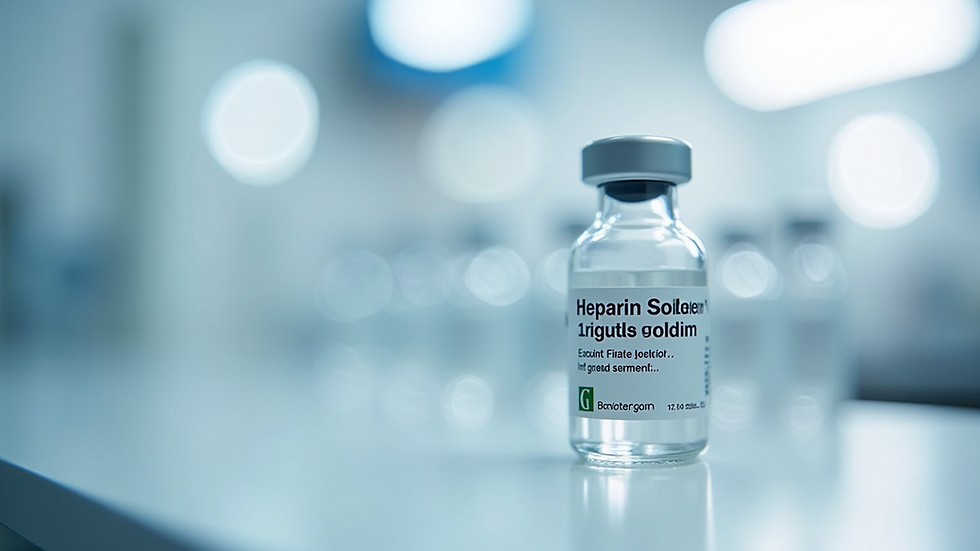Heparin Sodium Injection: A Closer Look
- Farbe Firma
- Sep 13
- 3 min read
Heparin sodium remains a cornerstone anticoagulant in modern medicine. Its role in preventing and treating blood clots is critical across various clinical settings. As a WHO-GMP certified pharmaceutical CMO/CDMO specializing in sterile injectables, we understand the importance of delivering high-quality, safe, and reliable formulations. This article provides a detailed examination of heparin sodium application, focusing on its uses, manufacturing considerations, safety profile, and industry standards.
Understanding Heparin Sodium Application in Clinical Practice
Heparin sodium is primarily used to prevent and treat thromboembolic disorders. It acts by enhancing the activity of antithrombin III, which inhibits clotting factors, thus reducing the formation of fibrin clots. This mechanism makes it invaluable in conditions such as deep vein thrombosis (DVT), pulmonary embolism (PE), and during surgeries requiring anticoagulation.
In clinical practice, heparin sodium is administered via injection, either intravenously or subcutaneously. The choice depends on the urgency and severity of the condition. For example:
Intravenous administration is preferred in acute settings like cardiac surgery or dialysis.
Subcutaneous injections are common for prophylaxis in hospitalized patients at risk of clot formation.
The dosing regimen requires careful monitoring, often using activated partial thromboplastin time (aPTT) to ensure therapeutic levels without increasing bleeding risk.

Manufacturing Excellence in Heparin Sodium Application
Producing heparin sodium injectable products demands stringent quality control and adherence to regulatory standards. As a WHO-GMP certified facility, we emphasize:
Sterility assurance: Our cleanroom environments and validated sterilization processes ensure injectable products are free from microbial contamination.
Consistency in potency: Each batch undergoes rigorous testing to confirm anticoagulant activity meets pharmacopeial standards.
Packaging integrity: Liquid ampoules, vials, and lyophilized products are sealed to maintain stability and prevent contamination.
Our manufacturing process integrates advanced technologies to maintain the molecular integrity of heparin sodium, ensuring efficacy and safety. This commitment supports healthcare providers worldwide in delivering optimal patient care.

Is Heparin Sodium High Risk?
Heparin sodium, while effective, carries inherent risks that require careful management. The primary concern is bleeding, which can range from minor bruising to severe hemorrhage. Risk factors include:
Overdosage: Excessive anticoagulation increases bleeding risk.
Patient-specific factors: Age, renal function, and concurrent medications influence safety.
Heparin-induced thrombocytopenia (HIT): A rare but serious immune-mediated reaction causing low platelet counts and paradoxical thrombosis.
To mitigate these risks, healthcare professionals must adhere to dosing guidelines and monitor patients closely. Laboratory tests such as platelet counts and coagulation profiles are essential during therapy. Additionally, alternative anticoagulants may be considered for patients with a history of HIT.

Regulatory Compliance and Quality Assurance in Heparin Sodium Production
Compliance with international regulatory standards is non-negotiable in the production of heparin sodium injectables. Our operations align with WHO-GMP guidelines, ensuring:
Traceability: Full documentation from raw material sourcing to finished product distribution.
Validation: Processes including sterilization, filling, and packaging undergo rigorous validation.
Stability testing: Products are tested under various conditions to guarantee shelf life and potency.
These measures protect end-users and support global distribution. Pharmaceutical distributors and importers rely on such compliance to meet their local regulatory requirements and maintain supply chain integrity.
Future Trends in Heparin Sodium Injectable Formulations
Innovation in anticoagulant therapy continues to evolve. While heparin sodium remains essential, advancements focus on:
Improved formulations: Enhancing stability and reducing adverse effects.
Alternative delivery systems: Exploring sustained-release injectables or combination therapies.
Biosimilar development: Expanding access through cost-effective manufacturing.
As a leading sterile injectable manufacturer, we invest in research and development to meet these emerging needs. Our goal is to provide healthcare providers with reliable, innovative solutions that improve patient outcomes globally.
In summary, the role of Heparin Sodium Injection in modern medicine is indispensable. Its application requires precise manufacturing, vigilant clinical use, and adherence to safety protocols. By maintaining the highest standards in sterile injectable production, we support the global healthcare community in delivering effective anticoagulant therapy.



Comments